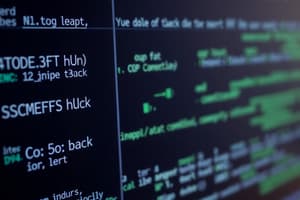Podcast
Questions and Answers
What is one of the primary roles of an operating system?
What is one of the primary roles of an operating system?
- To serve as a programming language
- To create computer hardware
- To write application programs
- To manage a computer’s hardware (correct)
How are operating systems generally designed?
How are operating systems generally designed?
- To run without any user interaction
- To be convenient or efficient, or both (correct)
- To provide endless memory options
- To be simple and small
Which of the following is NOT a responsibility of an operating system?
Which of the following is NOT a responsibility of an operating system?
- Memory management
- File management
- Managing peripheral devices
- Providing antivirus protection (correct)
What allows an operating system to function effectively?
What allows an operating system to function effectively?
In the context of operating systems, what is meant by 'subsystems'?
In the context of operating systems, what is meant by 'subsystems'?
During what period did the first generation of operating systems occur?
During what period did the first generation of operating systems occur?
What is the main purpose of the interface created by an operating system?
What is the main purpose of the interface created by an operating system?
What is one key feature of modern operating systems?
What is one key feature of modern operating systems?
What is the primary function of a distributed operating system?
What is the primary function of a distributed operating system?
Which of the following describes a characteristic of a multiprocessing operating system?
Which of the following describes a characteristic of a multiprocessing operating system?
What type of applications are best served by real-time operating systems?
What type of applications are best served by real-time operating systems?
Which of the following is NOT a type of real-time operating system?
Which of the following is NOT a type of real-time operating system?
What resources do hardware components provide for operating systems?
What resources do hardware components provide for operating systems?
How does a distributed operating system differ from a network operating system?
How does a distributed operating system differ from a network operating system?
In a multiprocessing operating system, what do multiple CPUs share?
In a multiprocessing operating system, what do multiple CPUs share?
Which scenario exemplifies the need for a real-time operating system?
Which scenario exemplifies the need for a real-time operating system?
What is the main function of an operating system?
What is the main function of an operating system?
Which of the following is NOT a service provided by an operating system?
Which of the following is NOT a service provided by an operating system?
Which CPU scheduling algorithm is designed to minimize the average waiting time for processes?
Which CPU scheduling algorithm is designed to minimize the average waiting time for processes?
What is a primary goal of process synchronization in an operating system?
What is a primary goal of process synchronization in an operating system?
Which type of operating system is characterized by the ability to run multiple processes simultaneously?
Which type of operating system is characterized by the ability to run multiple processes simultaneously?
What is a deadlock in the context of operating systems?
What is a deadlock in the context of operating systems?
Which of the following best describes the kernel of an operating system?
Which of the following best describes the kernel of an operating system?
Which concept is essential for inter-process communication?
Which concept is essential for inter-process communication?
What does the value of '0' in a bitmap typically represent?
What does the value of '0' in a bitmap typically represent?
How does a hash function facilitate the retrieval of values from a hash map?
How does a hash function facilitate the retrieval of values from a hash map?
In a bitmap representation, which of the following indicates the availability of resources?
In a bitmap representation, which of the following indicates the availability of resources?
What is a common application of hash functions in computer science?
What is a common application of hash functions in computer science?
Which of the following statements about a bitmap is true?
Which of the following statements about a bitmap is true?
What is the primary role of application programs?
What is the primary role of application programs?
Which system type aims to maximize resource utilization by sharing resources among multiple users?
Which system type aims to maximize resource utilization by sharing resources among multiple users?
What does an operating system do as a control program?
What does an operating system do as a control program?
How does a user's view of a computer vary among different systems?
How does a user's view of a computer vary among different systems?
What is the first step taken when a specific piece of information is needed?
What is the first step taken when a specific piece of information is needed?
What is the goal of a single user system?
What is the goal of a single user system?
In a multiprocessor environment, what issue arises due to the presence of multiple caches?
In a multiprocessor environment, what issue arises due to the presence of multiple caches?
What significant function does the operating system perform concerning requests for resources?
What significant function does the operating system perform concerning requests for resources?
What is the role of cache management in a caching system?
What is the role of cache management in a caching system?
Which system typically has little or no user view?
Which system typically has little or no user view?
What is one of the components of an I/O subsystem?
What is one of the components of an I/O subsystem?
What happens when a computer system is powered up or rebooted?
What happens when a computer system is powered up or rebooted?
Why is caching beneficial in a computing environment?
Why is caching beneficial in a computing environment?
What primarily drives the cache coherency issue?
What primarily drives the cache coherency issue?
Which statement about protection in a computer system is true?
Which statement about protection in a computer system is true?
What happens if data is not found in the cache?
What happens if data is not found in the cache?
Flashcards
Hash Function
Hash Function
A function that maps data of arbitrary size to a fixed-size value, often used for indexing and searching.
Hash Map
Hash Map
A data structure that uses a hash function to store and retrieve key-value pairs efficiently. It maps keys to specific locations in the data structure allowing quick access.
Bitmap
Bitmap
A string of bits, where each bit represents the status of a corresponding item. A 0 indicates that the item is available, while a 1 indicates that it is unavailable.
Indexing
Indexing
Signup and view all the flashcards
Ordered List
Ordered List
Signup and view all the flashcards
Application programs
Application programs
Signup and view all the flashcards
Operating System
Operating System
Signup and view all the flashcards
User View
User View
Signup and view all the flashcards
Single User System
Single User System
Signup and view all the flashcards
Mainframe or Minicomputer
Mainframe or Minicomputer
Signup and view all the flashcards
Workstations
Workstations
Signup and view all the flashcards
Operating System (as a Control Program)
Operating System (as a Control Program)
Signup and view all the flashcards
Operating System (Resource Allocator)
Operating System (Resource Allocator)
Signup and view all the flashcards
What is an operating system?
What is an operating system?
Signup and view all the flashcards
First Generation Operating Systems
First Generation Operating Systems
Signup and view all the flashcards
Mobile Operating Systems
Mobile Operating Systems
Signup and view all the flashcards
Modular Design of OS
Modular Design of OS
Signup and view all the flashcards
Operating system as an interface
Operating system as an interface
Signup and view all the flashcards
Design Goals of OS
Design Goals of OS
Signup and view all the flashcards
OS as a foundation for applications
OS as a foundation for applications
Signup and view all the flashcards
Resource Management by OS
Resource Management by OS
Signup and view all the flashcards
Resource management in operating systems
Resource management in operating systems
Signup and view all the flashcards
Protection and security in operating systems
Protection and security in operating systems
Signup and view all the flashcards
Process management
Process management
Signup and view all the flashcards
CPU scheduling
CPU scheduling
Signup and view all the flashcards
Memory management
Memory management
Signup and view all the flashcards
Mass storage structures
Mass storage structures
Signup and view all the flashcards
System protection
System protection
Signup and view all the flashcards
Cache
Cache
Signup and view all the flashcards
Cache Coherency
Cache Coherency
Signup and view all the flashcards
Cache Management
Cache Management
Signup and view all the flashcards
Caching
Caching
Signup and view all the flashcards
Protection
Protection
Signup and view all the flashcards
Memory-Management Component
Memory-Management Component
Signup and view all the flashcards
Device-Driver Interface
Device-Driver Interface
Signup and view all the flashcards
Hardware Device Drivers
Hardware Device Drivers
Signup and view all the flashcards
What is a Distributed OS?
What is a Distributed OS?
Signup and view all the flashcards
How does a Dist OS extend Network OS?
How does a Dist OS extend Network OS?
Signup and view all the flashcards
What is a Multiprocessing OS?
What is a Multiprocessing OS?
Signup and view all the flashcards
How does a Multiprocessing OS enhance efficiency?
How does a Multiprocessing OS enhance efficiency?
Signup and view all the flashcards
What is a real-time OS?
What is a real-time OS?
Signup and view all the flashcards
What are some examples of real-time OS applications?
What are some examples of real-time OS applications?
Signup and view all the flashcards
What is a Hard Real-Time OS?
What is a Hard Real-Time OS?
Signup and view all the flashcards
What is a Soft Real-Time OS?
What is a Soft Real-Time OS?
Signup and view all the flashcards
Study Notes
Course Information
- Course name: Operating Systems
- Course code: CSEN1101
- Department: CSE, GST
- Instructor: GVSN
Course Educational Objectives
- Introduce basic operating system concepts, functions, and services
- Provide basic concepts of process management and synchronization
- Familiarize students with deadlock issues
- Explain various memory management schemes
- Provide exposure to mass storage structures and system protection
Syllabus - Module I
- Operating System Structures
- Introduction: computer system organization, architecture, operating system structure, resource management, Protection, and security, kernel data structures
- Operating system services, system calls, loaders and linkers, operating system structure, building and booting an operating system.
Syllabus - Module II
- Process Management and CPU Scheduling
- Process concepts, process scheduling, Operations on processes, and inter-process communication
- Multithreaded programming, Multi-core Programming, Multi-threading Models
- Scheduling criteria, scheduling algorithms, algorithm evaluation
Syllabus - Module III
- Process Synchronization and Deadlock
- Critical section problem, Peterson's solution
- Synchronization hardware, Mutex locks, semaphores, monitors
- Classic problems of synchronization
- System model, deadlock characterization, deadlock prevention, deadlock avoidance, deadlock detection, recovery from deadlock
Syllabus - Module IV
- Memory Management and Virtual memory
- Swapping, contiguous memory allocation, paging, segmentation, structure of page table
- Demand paging, Copy-on-Write, page replacement, allocation of frames, thrashing
Syllabus - Module V
- Mass-storage structure and System Protection
- File concept, access methods, directory and disk structure, protection
- Overview of Mass-Storage Structure, disk scheduling, Swap space management
- Goals of protection, principles of protection, Domain of protection, Access matrix
Textbooks and References
- Silberchatz, Galvin, Gagne: Operating System Concepts, 10/e, John Wiley (2018)
- Tanenbaum: Modern Operating Systems, 2/e, Pearson/PHI (2014)
- Crowley: Operating System- A Design Approach, McGraw-Hill (2012)
- Stallings: Operating Systems - Internal and Design Principles, 5/e (2013)
- Pal Chaudhary: Operating system principles & Design, 1/e, PHI Learning (2013)
- Deitel and Deitel: Operating System, Pearson Education (2003)
- D.M. Dhamdhere: Operating systems- A Concept based Approach, 2/e, McGraw Hill (2010)
Course Outcomes
- Illustrate the basic and overall view of operating system
- Analyze the concept of a process, process life cycle, process states and state transitions
- Implement and practice CPU scheduling strategies, process synchronization techniques and memory-management schemes
- Simplify and resolve Deadlock handling situation
- Evaluate Disk storage management, protection and security mechanisms
CO-PO Mapping
- (See provided table)
Learning Outcomes
- Explain the main responsibilities of an operating system (OS) and the history leading to their current form
- List the most fundamental subsystems and services of OS
- Analyze and list out different system calls
Introduction
- An operating system (OS) manages hardware and provides a basis for application programs.
Generations of Operating Systems
- First Generation(1940-1950s):No OS, tasks coded in machine language
- Second Generation(1955-1965): GMOS, batch processing
- Third Generation(1965-1980):Multiprogramming
- Fourth Generation (1980-Present): Personal computers, Windows, Mac OS
Types of Operating Systems
- Batch, Time-Sharing, Embedded, Multiprogramming, Network, Distributed, Multiprocessing, and Real-time
Advantages of Operating System
- Helpful for monitoring and regulating resources
- Easy to operate with Graphical User Interface
- Creates interaction between users and applications/hardware
- Improves computer system performance, response time, and throughput
- Facilitates sharing of diverse resources.
Disadvantages of Operating System
- Limits the number of concurrent tasks
- Stored data can be destroyed if errors occur.
- Security threats (viruses) could affect the system
- Unrecognized users can use the system without permission
- System cost can be high.
Computer-System Organization
- Computer-System Operation: A bootstrap program starts running the computer system..
- Storage Structure: CPU loads instructions and data from memory (RAM). Memory is an array of bytes, each with an address.
- I/O Structure: I/O devices are controlled by device controllers; drivers coordinate I/O operations, using techniques like interrupts and DMA (Direct Memory Access).
- Computer-system architecture:
- Single-Processor Systems: One CPU
- Multiprocessor Systems: Multiple CPUs; can be asymmetric (one CPU controlling others) or symmetric (equal CPUs).
- Clustered Systems: Multiple independent systems (nodes) connected tightly via the network, used for high availability.
Operating System Structure and Operations
- Multiprogramming: Using multiple jobs, allowing the CPU or I/O devices to be busy.
- Time-sharing: A logical extension of multiprogramming, offering interaction with programs while they run.
- Operating System Operations: Interrupts signals events occurring in the hardware or software, allowing the OS to respond.
- Dual/Multi-mode operation: The OS utilizes special modes of operation (user mode, kernel mode) controlled by a mode bit in the computer's hardware, for process management.
Process Management
- A process is an executing program
- The operating system is responsible for scheduling processes and threads, creating processes, suspending/resuming them, and implementing mechanisms for synchronization and communication between processes.
Memory Management
- The operating system manages memory usage. This includes mapping programs to memory addresses, tracking memory usage by processes, allocating, and deallocating memory as needed.
Storage Management
- File System Management: The OS manages files, which are collections of related information viewed by the user as logical units and mapped to physical storage.
- Mass Storage Management: Includes managing disks, free-space management, disk allocation, and disk scheduling.
- Caching: Information is temporarily stored in a cache for quick access. (Hierarchy of storage levels)
Protection and Security
- Protection controls access to system resources.
- Security defends the system from external and internal attacks (viruses, worms, denial-of-service attacks, identity theft, etc.).
- The OS (typically) tracks user identities (e.g., numerical IDs such as SIDs - security identifiers)
Kernel Data Structures
- Lists, Stacks, and Queues: Arrays, linked lists, stacks, queues, trees, hash functions and maps, bitmaps are basic data structures for management within the operating system.
Studying That Suits You
Use AI to generate personalized quizzes and flashcards to suit your learning preferences.




